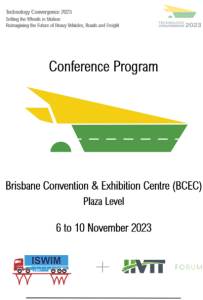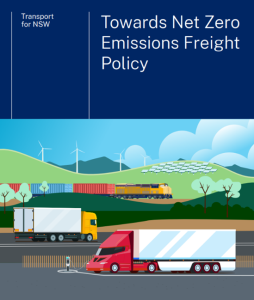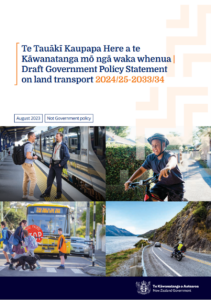September 2023 Newsletter
Dear HVTT Forum family
I’m writing to you from Sydney, Australia, where we’re experiencing a warm beginning to Spring (more on this later).
With only a handful of weeks to go before Technology Convergence 2023 – the joint conference of the 17th International Symposium for Heavy Vehicle Transport & Technology (HVTT17) and the
9th International Conference on Weigh-In-Motion (ICWIM9) – you’ll need to forgive me for making it a focus of this newsletter.
The final countdown to Technology Convergence 2023
Technology Convergence 2023 is now only five weeks away!
After two years of planning and behind-the-scene activities, we’re on the cusp of hosting a global conference which will showcase the latest research, knowledge, and developments aimed at advancing the management of heavy vehicles, roads and freight.
As you’ll recall, the decision to hold HVTT17 and ICWIM9 together into a single conference leverages the strong and long-standing relationships between the International Forum for Heavy Vehicle Transport & Technology (HVTT Forum) and the International Society for Weigh-In-Motion (ISWIM). The combined efforts of the HVTT Forum and ISWIM in organising the conference have further strengthened this relationship.

Technology Convergence 2023 will be held at the Brisbane Convention & Exhibition Centre (BCEC)
Converging technology
The theme of Technology Convergence 2023 – Setting the Wheels in Motion: Reimagining the future of heavy vehicles, roads and freight – was chosen to focus on the opportunities which emerge from the disruptive nature of new technologies.
These disruptions force us to review customary ways of thinking, question traditional assumptions, and challenge conventional bodies of knowledge. It also provides opportunities for new bodies of knowledge to emerge, and allows us to break through real or perceived constraints.
A common thread emerging through the scientific program is how the rapid shift to Low and Zero Emission Heavy Vehicles is forcing us to revisit the way we manage the interaction between heavy vehicles and roads – and how the combined use of vehicle and road-based technologies to measure vehicle utilisation can enable improved outcomes (more on this later during the Australian update).
Announcement of conference program
This newsletter coincides with the release of the final program by the Joint Organising Committee and the Joint Scientific Committee for Technology Convergence 2023.
On behalf of the Joint HVTT Forum and ISWIM Scientific Committee, I wish to thank each and every author who took the time to prepare and submit abstracts, draft full papers and final papers for the conference. Without you, we wouldn’t have a conference to host! Likewise, we wouldn’t have a scientific conference without the efforts of those who reviewed the abstracts and papers, and provided feedback to authors.
I would also like to thank the authors from Australia and New Zealand, who’ve been so willing to share their local knowledge and experiences with conference delegates from the rest of the world.

Extension of early bird tickets
I’m pleased to advise that, in conjunction with ISWIM, we’ve made a decision to extend early bird registrations by three weeks (to 22 October).
While we’ve already attracted a significant number of registrants thus far (thanks to each of you!), we want to make sure that no one misses out on the opportunity to attend Technology Convergence 2023 – recognising that both the HVTT Forum and ISWIM are not-for-profit membership-based organisations in allied sectors.

Some interesting facts ahead of Technology Convergence 2023
In the lead-up to the conference, I thought I’d share some interesting facts with you (which may be less familiar to newer members of the HVTT family):
- The HVTT Forum and ISWIM last held a joint conference together in 2008 in Paris, France.
- It’s been thirteen years since Australia last hosted the HVTT Forum in Melbourne, Victoria in 2010. Prior to that, the International Symposium on Heavy Vehicle Weights and Dimensions (the forerunner to the HVTT Forum) was held in Maroochydore, Queensland in 1998.
- It’s been five years since the HVTT Forum members have met in person, where HVTT15 was held in Rotterdam, The Netherlands, in 2018.
- Due to global travel restrictions associated with COVID–19, our colleagues in China successfully held HVTT16 online – in what was the first online symposium for the HVTT Forum. The hosting of regional hubs was another HVTT Forum first, which complemented the online arrangements for HVTT16.
I also want to share some key metrics for Technology Convergence 2023, which signals the strength of the conference, as well as its global reach:
- Number of full scientific papers accepted: 72
- Number of authors (of scientific papers): 204
- Number of countries represented (by author): 23
- Number of keynote speakers: 9
- Number of sponsors and exhibitors: 16
- Number of countries represented (by sponsor/exhibitor): 8
We trust that you’re all looking forward to attending Technology Convergence 2023 as much as we are!
With that, let’s turn to what else is happening in Australia and on the ‘other side of the ditch’ in New Zealand.
Updates from Australia
Increase in vehicle width
Last week, the Australian Government announced the Safer Freight Vehicles Package, which will increase the maximum width of heavy vehicles from 2.5 to 2.55 metres for new trucks fitted with specific safety features.
These safety features include blind spot monitoring, electronic stability control, advanced emergency braking, lane departure warning system, better reflective markings, and side protection guards to stop pedestrians and cyclists from being caught up under the rear wheels of trucks. Furthermore, safety devices and sensors (such as front and kerb view mirrors, external parts of camera monitor systems, blind spot sensors, and cross-view mirrors) can be fitted without counting towards width and length measurements.
The move brings Australia into line with major overseas markets, and allows the Australian transport industry to gain access to the latest generation of heavy vehicles from overseas – including Low and Zero Emission Heavy Vehicles.
Low and Zero Emission Heavy Vehicles
Battery electric heavy vehicles are now beginning to be used on Australia’s road networks.
Increased tare weights of battery electric prime movers (a function of battery size) can challenge existing regulatory envelopes, and focus the collective minds of government and industry maintaining payload and productivity, while managing infrastructure and safety.
Australian policy makers are once again turning to technology and data to help navigate these familiar challenges, with intelligent access and Smart On-Board Mass (OBM) technology being deployed as a condition of operation for many battery electric heavy vehicles.
In the last month, two Australian jurisdictions have released details of battery electric heavy vehicle arrangements on their networks.
Victoria has introduced a vehicle monitoring scheme which uses intelligent access and Smart OBM; while South Australia has launched a twelve-month trial – again using intelligent access and Smart OBM.
Queensland is also currently running a study using intelligent access and Smart OBM to assess the impacts of battery electric heavy vehicles on the state’s road networks.
Just hours before sending this newsletter out, the New South Wales Government announced its Towards Net Zero Emissions Freight Policy, which focuses on reducing the carbon footprint created by heavy road vehicles and rail freight. The Policy is framed around short (0-2 years), medium (3-5 years) and long (5+ years) term actions and adopts a staged approach for the journey ahead.
The policy considers current and emerging technologies and barriers to the adoption of these technologies, and will introduce concessions on mass limits for heavy LZEVs operating on the State-road network.

Smart OBM
Smart OBM is now being used in Australia to improve the productivity and safety of specific heavy vehicle combinations in Australia. Using digital technologies which are connected to intelligent access arrangements, Smart OBM systems collect and transmit axle mass data from heavy vehicles and trailers.
In Australia, specific kinds of heavy vehicles now need Smart OBM to legally operate in the Australian jurisdictions of Tasmania, Victoria, New South Wales, South Australia and Queensland. Managers of road infrastructure from these jurisdictions are using data collected from Smart OBM (coupled with intelligent access-derived vehicle location data) to:
-
Better understand the use of their networks by heavy vehicles;
-
Monitor the safe use of the network and vulnerable assets by participating vehicles; and
-
Inform the lifecycle management of road and bridge infrastructure.
This is a practical implementation of the approaches contained in the OECD/ITF publication on Policies to Extend the Life of Road Assets (which was informed by members of the HVTT Forum and ISWIM).
Update from New Zealand
Draft Government Policy Statement (GPS) on Land Transport 2024
Like many regions globally, the resilience of the New Zealand road network is feeling the impacts of climate change. Cyclones and flooding have resulted in considerable damage in recent times, with significant costs being incurred with recovery and repair.
In this light, there is a growing awareness of the importance of roads as an economic utility, and the need for investment to maintain and drive economic growth, and support supply chains. This has been reflected in a draft Government Policy Statement (GPS) on Land Transport 2024, which was released for consultation in August by Te Manatū Waka (New Zealand Ministry for Transport).
The GPS outlines the government’s strategic priorities for a ten-year period (2024-25 to 2033-34), including:
- Maintaining and operating the system
- Increasing resilience
- Reducing emissions
- Safety
- Integrated freight system
- Sustainable urban and regional development.
The GPS on Land Transport 2024 is scheduled to come into effect from 1 July 2024.

Changes to speed limits
There has also been recent work to review speed limits in New Zealand as part of the government’s Road to Zero initiative – which is guiding road safety improvements over a ten-year period through to 31 December 2029.
Numerous speed limit changes are being introduced across the network, with some open roads having speed limits reduced from 100 km/h to 80 km/h (noting that trucks have a maximum speed limit of 90km/h), and some urban roads being reduced from 50 km/h to 30 km/h.
With the vast majority of the New Zealand road network being two-lane undivided roads, the changes to speed limits are intended to improve road safety and reduce the incidence of crashes where speed is a factor.
Finally, to the weather
In terms of weather, Australia has moved from a dry winter to a dry (and unseasonably warm) spring in the Southern Hemisphere.
Sydney experienced its equal-hottest day on record during September (with a maximum temperature of 34.6°C / 94.3 °C being recorded) and on Sunday, we had temperatures in Sydney which broke new records for the beginning of October.
Looking forward to November, Brisbane usually enjoys daytime temperatures that range from 25°C to 30°C (77°F to 94.3°F) and sees an average of eight hours of sun per day and high humidity thanks to its subtropical climate. Please remember to pack sunscreen, a hat, and suitable clothes for the weather.
I hope you can make the time to join us at Technology Convergence 2023. I look forward to seeing you there!
Regards,
Gavin Hill
Vice-President: Australasia and Pacific
HVTT Forum
PS. If you’re reading this from Australia, and aren’t yet planning to come to Technology Convergence 2023, do consider joining us – the next time Australia gets to host a HVTT Forum won’t be for another decade or so!
